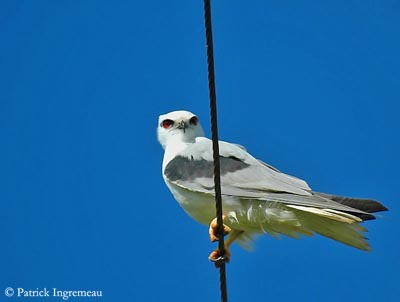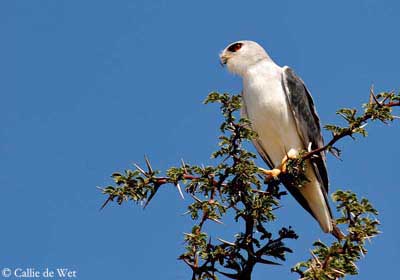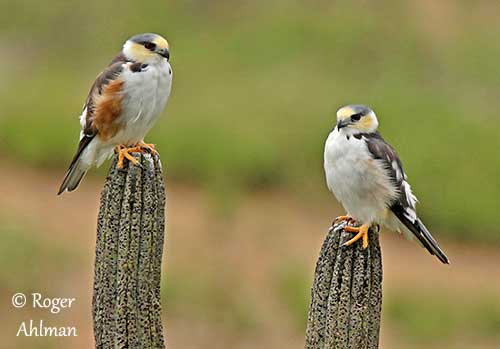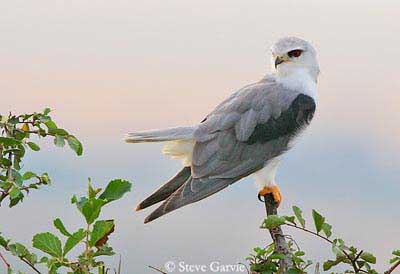
Looking at these pictures, we can understand how these raptors are similar to each other, as well in physical traits as in their postures and behaviour.
Text by Nicole Bouglouan
Photographers:
Roger Ahlman
Pbase Galleries Peru and Ecuador & My bird pictures on IBC
Steve Garvie
RAINBIRDER Photo galleries
Patrick Ingremeau
TAMANDUA
Tom Grey
Tom Grey's Bird Pictures
Tom Merigan
Tom Merigan’s Photo Galleries
Callie de Wet
GALLERY
Sources :
HANDBOOK OF THE BIRDS OF THE WORLD Vol 2 by Josep del Hoyo-Andrew Elliot-Jordi Sargatal - Lynx Edicions - ISBN: 8487334156
L’ENCYCLOPEDIE MONDIALE DES OISEAUX - Dr Christopher M. Perrins - BORDAS - ISBN: 2040185607
GUIDE DES RAPACES DIURNES – Europe, Afrique du Nord et Moyen-Orient de Benny Génsbol – Delachaux et Niestlé – ISBN : 2603013270
ENCYCLOPEDIE DES OISEAUX DE FRANCE ET D’EUROPE – de Peter Hayman et Rob Hume - Flammarion – ISBN : 2082009920
Cuckoo-hawks, Kites, Honey-buzzards
Second subgroup
The second subgroup includes three genera, Gampsonyx, Chelictinia and Elanus. These raptors feed both on small insects and rodents. They have peculiar trait, making them different from others. Their talons are flat or rounded, not grooved as in other birds of prey.
The first genus, Gampsonyx, has only one member, the Pearl Kite (Gampsonyx swainsonii) which is the smallest with a length of 20-28 centimetres and a weight of about 94 grams.
In spite to be very similar to some falconets such as the Pigmy Falcon in the family Falconidae, this species shows anatomical features indicating that it is a kite, closely related to the genus Elanus.
This small raptor has blackish upperparts. Underparts are white with black patch on breast side and chestnut thighs. The head shows orange-buff forehead and cheeks patches, and indistinct white nuchal collar bordered by dark rufous band. The bill is black. The eyes are brown. Legs and feet are bright yellow.
It frequents dry, arid and shrubby areas, savannahs and open tropical woodland. It feeds mainly on lizards, but also takes large insects and occasionally small birds. It hunts from a perch from which it dives onto the prey.
The male performs aerial displays such as flutter-glide flight, and courtship feeding occurs before copulation. The twig nest is placed in tree, at tip of horizontal branch. Two or three eggs are laid. Incubation in mainly by female and lasts 34-35 days, and the young fledge about five weeks after hatching.
This species seems to be sedentary in its range in the northern half of South America. Only the young birds perform some dispersion.
The Pearl Kite is not usually common, but it benefits from forest destruction, and populations are not currently threatened.
The second genus Chelictinia has also only one member, the African Swallow-tailed Kite (Chelictinia riocourii).
This beautiful raptor is very similar to a tern, as well in flight as in appearance with its grey and white plumage and the long outer rectrices. It has grey bill with yellow cere, deep red eyes and yellow-orange legs and talons.
It frequents arid steppes and scrubby savannahs in sub-Saharan Africa, from Senegambia to Ethiopia and Somalia, and to NE Uganda and NE Kenya.
This is a gregarious species, sleeping at communal roost at night and hunting in loose flocks. It feeds primarily on insects and spiders, but during the breeding season, it also takes lizards and rodents. It hunts on the wing, by soaring and hovering before to descend to hawk the flying prey or catch it on the ground.
It may nest in loose colonies. The small stick nest is placed in thick thorny bush. Usually four eggs are laid.
This kite performs regular seasonal movements related to the rains.
The species is vulnerable to degradation of the habitat and pesticides. However, populations seem to be locally common in spite of decline in some parts of the range.
The third genus Elanus includes four species similar to each other. These kites have grey, black and white plumage. The underparts are white and the upperparts grey with conspicuous black wing patch, slightly different from one species to other. Some differences can be seen on the underwing where the carpal patch is more or less important or absent in the Black-winged Kite (Elanus caeruleus) from Sub-Saharan Africa, India, S Asia and SW Iberian Peninsula. The underwing tip is black in all species except in the Letter-winged Kite (Elanus scriptus) from Australia.
They have black bill with yellow cere, deep red eyes and yellow legs and feet.

Elanus caeruleus
They usually frequent open areas with scattered trees and bushes, arid steppes, desert and clearing in dense woodland, grassland and habitats with ground cover. The White-tailed Kite (Elanus leucurus) from the Americas prefers open cultivated areas, scarcely wooded savannahs and marshes.
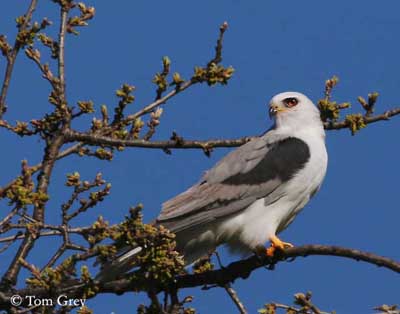
Elanus leucurus
They feed primarily on rodents, but also take other small mammals, birds, lizards, amphibians and insects. They are mainly crepuscular, but they are active by day too. The Letter-winged Kite is nocturnal, as its preferred preys, and this habit is almost unique in this family.
They hunt from a perch or by hovering before to drop onto the prey.
The White-tailed Kite does not use perch, but it is able to catch small birds in flight.
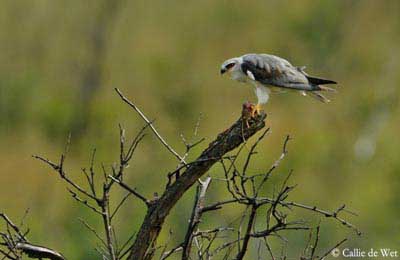
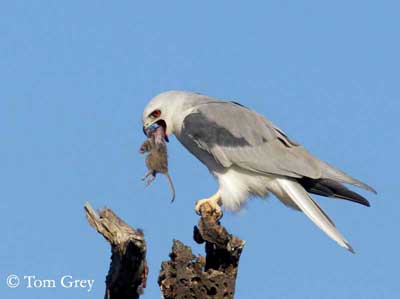
They can breed solitary or in loose colonies. The nest is a platform of sticks, twigs and grass, placed in trees, often in canopy of live tree. The Black-shouldered Kite (Elanus axillaris) places its nest in fork of tree, in bush or pylon.
They lay three to five eggs and the incubation lasts between 30 and 36 days. The young are fed by both parents, and fledge between 30 and 40 days after hatching.
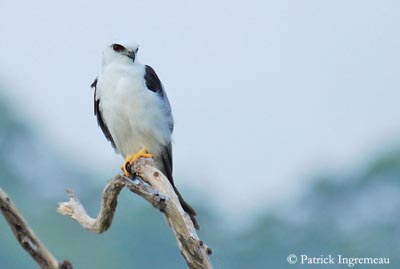
Black-shouldered Kite
Elanus axillaris
These species do not really migrate but perform nomadic and dispersive movements according to the food availability.
The Australian Black-shouldered Kite (Elanus axillaris) from Australia is resident in temperate coastal lowlands, but movements are observed, related to the prey availability.
The White-tailed Kite southernmost populations move northwards in winter. They congregate in large flocks outside the breeding season.
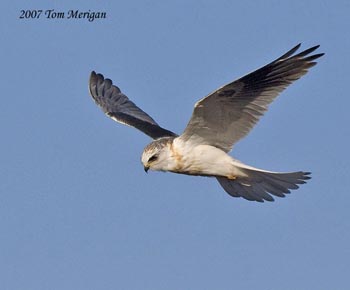
Elanus leucurus
The Black-winged Kite and the Black-shouldered Kite are common and widespread. The White-tailed Kite is increasing in most parts of the range. The Letter-winged Kite is usually uncommon and threatened by degradation of the habitat and increase of feral cats. It is considered as Near Threatened.
